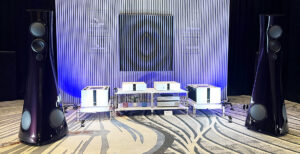
AURALIC’s GEMINI 2000 and 1000 products were first drawn to my attention, if I remember correctly, last October at the Rocky Mountain Audio Fest 2013. At the time, the products were in their final pre-production prototype phase, but even then they showed a great deal of promise.
What are these GEMINI models? In simple terms, they are elegant and beautifully made headphone stands that just happen to incorporate both built-in class A headphone amplifiers and ultra-capable high-res PCM, DXD, and DSD capable DACs. The GEMINI 2000 sells for $1995 in the US (or £1,890 in the UK), while the 1000 is priced at $1,199 in the US (or £1,090 in the UK).

What’s the difference between the GEMINI 2000 and 1000? In terms of general appearance, build quality, and DAC section capabilities, the 2000 and 1000 are identical, but the 2000 offers a class A amplifier with singled-end and fully balanced outputs serving up 2,000 mW of output power, while the 1000 offers single-ended outputs only and provides 1,000 mW of power. The only other difference is that the 2000’s polished, plated brass plinth is offered in the buyer’s choice of gold or silver finishes, while the 1000’s plinth is done in titanium grey. Both models are offered in hand-rubbed finishes in gloss black, white, blue, yellow, and red. Our review unit is a GEMINI 2000 done up in gloss red with gold trim (a combination that conveys a certain Scuderia Ferrari vibe, as I see it).
Quite honestly, dyed-in-the-wool high-end audio purists might initially be tempted to dismiss the GEMINI models because they seem almost too pretty to take seriously. In truth, the GEMINIs don’t look like traditional high-end audio components at all; rather, they look like beautiful, sculptural art objects (or perhaps like the avant garde trophies that might be awarded at some desperately fashionable, futuristic music festival).

But, my fellow high-enders, please take note: if you can set aside biases and preconception concerning “style-led” products for a moment and give the GEMINIs an open-minded listen, it will immediately become apparent that their beauty is more than skin-deep. On the contrary, these svelte stand/amp/DACs offer serious sonic excellence of the sort that could make any number of competing amp/DAC makers green with envy. Add to this the fact that the GEMINIs are more than fairly priced for the sound quality on offer and you quickly realise you’ve got something very special in hand: namely, components that combine aesthetic beauty, sonic excellence, and excellent value for money, all in one go.
Here’s the basic scenario: the GEMINIs draw upon several reservoirs of established design expertise, each of which comes with impeccable credentials.

Seeking inspiration for the DAC and amplifier sections of the GEMINI units, AURALiC turned to its own critically acclaimed and much more costly VEGA Digital Audio Processor (£2, 890; reviewed in Hi-Fi+ Issue 106) and TAURUS MK II Balanced Output Headphone Amplifier/Preamplifier (£ 1,499; reviewed in Hi-Fi+ Issue 105). I imagine that about now many of you might be thinking, “Surely you don’t mean to suggest that a stylish, sub-£2000 combo product can closely mimic the sound of an extremely well-regarded, £4,389 pair of separates.” Well, in all candour, that is exactly what I’m about to suggest.


True, in an absolute sense, the VEGA/TAURUS MK II combo does sound a smidgeon better and a touch more focussed and refined, and it is also more versatile and more powerful than the GEMINI. On the other hand, once you give the GEMINI a half hour of warm-up time or so, the sonic resemblance between its sound and that of the VEGA/TAURUS MK II combo is unmistakable. What I am thinking, then, is that for many headphone listeners the gap will be sufficiently narrow as to make the selection of the GEMINI a no-brainer. It truly is that good.
Let’s look briefly at how the GEMINI 2000 compares to the VEGA/TAURUS MK II combination:
- Digital Formats: Both the VEGA and GEMINI 2000 products can handle digital audio file formats ranging from 44.1kHz/16-bit PCM files on up to DXD (that is 384 kHz/32-bit), and also can process DSD64/128 files.
- Upsampling: The VEGA upsamples all incoming digital signals to 1.5MHz/32-bit levels and then performs all decoding/filtering tasks on those very high-resolution data streams. The GEMINI uses some form of upsampling (presumably a pared-down version of the VEGA’s systems), but few details on the specifics are given.
- Digital Inputs: The VEGA provides USB, coaxial and optical S/PDIF, and AES/EBU inputs. The GEMINI provides USB, Android phone, and optical S/PDIF inputs.
- Digital Filters: The VEGA provides an extensive array of user-selectable digital filters with separate sets of filters for PCM and DSD playback. The GEMINI does not provide user-selectable filters, but does borrow filter technology derived from the VEGA.
- Driver Support: The VEGA automatically connects to Mac family computers, but requires installing a separate driver for use in Windows-based systems. The same is also true of the GEMINI, though one very big difference involves the manner in which the driver is implemented. The VEGA ships with a CD/ROM containing its Windows driver, which must be loaded and installed on the Windows PC in question before the VEGA can be used. The GEMINI, however, features an onboard 4GB SDXC memory card on which is found both the requisite Windows driver, an install guide, and also some music playback software (which I have not, as yet, tested). The cool part about this is that the driver travels with the GEMINI wherever it goes and is always “install ready”, so that if you were to take the GEMINI to a friend’s home or to your office, you would be also set to connect it to whatever PC might fall readily to hand.
- Clock: The VEGA provides an exceedingly precise “femtoclock” with multiple user-selectable clock control settings. The GEMINI uses a clock system regulated by “three low jitter crystals”, but does not provide user-selectable controls.
- Analogue Inputs/Outputs: The VEGA provides balanced and single-ended analogue outputs suitable for driving preamps or integrated amps, or the VEGA can actually be used as a digital preamplifier in its own right. The GEMINI’s only analogue outputs are its headphone outputs (the GEMINI 2000 supplies one single-ended and one balanced headphone output). The TAURUS MKII provides two sets of single-ended and balanced analogue outputs—one for driving ancillary components such as preamps or integrated amps, the other for driving headphones.
- Power Output: The TAURUS MK II puts out a maximum of 4500 mW at 120 Ohms in balanced mode, whereas the GEMINI 2000 out a maximum of 2000 mW into an unspecified load in balanced mode.
All of the electronics of the GEMINI are, through the miracle of miniaturised surface mount devices, fitted into the thick, disk-shaped brass plinth of the unit. To appreciate what I mean by “miracle of miniaturisation”, understand, please, that the GEMINI amp/DAC section contains over 500 discrete parts packed into a cylindrical space only about six inches in diameter and a bit less than an inch thick! AURALiC uses brass for the plinth because it says the material offers more desirable heat dissipation characteristics than does the more commonly used aluminium.

The plinth design is the epitome of elegant minimalism, offering just two plated brass pushbuttons (one as a master on/off switch, the other as a digital input selector), plus a plated brass volume control thumbwheel. Three tastefully subdued (and physically recessed) groups of LEDs are use to show the file format in play at any given moment, the current volume settings chosen by the user, and the input selected. One whimsical detail is that, for reasons known only to AURALiC, the volume control is for some reason labelled “NICENESS”. On the rear side of the plinth is a recessed bay providing a USB port for PCs and MACs, a mini-USB port for Android phones, an optical S/PDIF port, a socket for connecting the GEMINI’s outboard power supply, and a slot where the included 4GB SDXC memory card is installed.

The aesthetic and functional design of the stand section of the GEMINI has been licensed from the Swedish firm Klutz Design, whose beautiful yet highly functional headphone stands have found their way onto many a headphonista’s wish list. Apart from the stand’s sleek good looks, the design is functional, too, offering gently curved top surfaces that support the weight of stored headphones without putting undue stresses on (or creases in) even the most delicate of headband pads. Recognising that, lo, headphones do in fact have signal cables that need to be stored safely when the headphones are not in use, the Klutz/GEMINI stand provides a pair of forward facing posts that serve as a ‘spool’ around which users can gently coil their headphone’s signal cables when not in use. (Why haven’t other stand makers figured this out long ago?)
One interesting design wrinkle, however, is that AURALiC builds its version of the Klutz stand with—in the GEMINI 2000—a forward-facing ¼-inch headphone jack (for the single-ended output) and a rear-facing 4-pin XLR connector (for the balanced output). By design, when users connect headphones to the ¼-inch headphone jack, the unit automatically powers up (and vice versa).

On paper and in real-world practice, the VEGA/TAURUS MK II pair is more capable that the GEMINI, to be sure, but the important point to remember is that—through most headphones most of the time—the perceived performance gap is surprisingly narrow. In other words, if you’ve yearned to own the VEGA/TAURUS MK II pair for purposes of extracting the highest possible levels of performance from your favourite headphones, the GEMINI stands as a lovely, sonically rewarding, and less-that-half-the-price solution. But then, consider the fact that the GEMINI is very compact, very easy to set up and use, and extremely beautiful to look at, and you can really start to catch the vision for what the GEMINI is meant to be and do.
How does the GEMINI sound? It sounds surprisingly much like the VEGA/TAURUS MK II’s overachieving younger brother. That is to say that the DAC section offers plenty of focus and resolution, taut timing, and expressive dynamics, while the amp section offers a pleasing blend of detail, definition, dynamic agility, and natural warmth. While the GEMINI can, when first powered up, sound just a bit “wooden” or “flat”, it warms up quite rapidly, sound lively, more lifelike, and appropriately energetic as it does. It is also surprising powerful, so that it can drive the notoriously difficult HiFiMAN HE-6 headphones with headroom to spare.

Even though I have AURALiC’s VEGA and TAURUS MK II on loan to use as a reference product, I never felt I was “stepping down” in any way when I listened through the GEMINI. In fact, I found the GEMINI a joy to use and I also felt that, quite frankly, it sounded far more accomplished and refined than I had thought it would. I flat out love listening through the thing.
Are there caveats? There is one that, while not damning, is somewhat troubling. Specifically, when the GEMINI is fully warmed up, its plated brass plinth of gets quite hot to the touch. Honestly, temperature levels are high enough that, if you rest your hand on the fully warmed-up plinth for more than about three seconds, you will experience serious discomfort. (Manly men who like to prove their toughness by holding their hands inches above open flames will feel right at home, here.) In practice, one soon learns to adjust volume levels swiftly and smoothly to avoid prolonged hand contact with the plinth, but my concern is for small children who might grasp the bright, shiny plinth only to receive and unexpected (albeit minor) burn. My point: in future evolutions of the GEMINI product, I would love to see AURALiC explore additional internal or external heat-sinking so as to reduce surface temperatures to more user friendly levels.
Still, the foregoing comments in no way diminish my enthusiasm for the GEMINI 2000. If you want a big—and I mean really big—taste of what top-tier headphone electronics can be like, yet at a price that must be considered a bargain, then look no further.
Watch for the upcoming Hi-Fi+ review of the AURALiC GEMINI. Until then, we wish you happy listening.
Tags: FEATURED
By Chris Martens
More articles from this authorRead Next From Blog
See all
AXPONA 2024 Show Report Part One
- Apr 19, 2024

Audio Show Deluxe 2024: A photo show report
- Mar 28, 2024

Paul Messenger 1949-2024: A personal tribute
- Mar 26, 2024

Bristol Hi-Fi Show 2024: See You There!
- Feb 21, 2024










